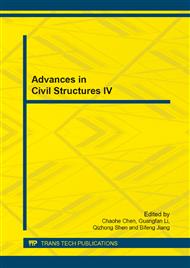p.1459
p.1464
p.1469
p.1473
p.1477
p.1482
p.1489
p.1493
p.1498
Analysis of Concrete Corrosion and Damage Mechanism under the Actions of Multiple Salts and Dry-Wet Cycles
Abstract:
On the basis of concrete durability experimental results under the actions of multiple salts and dry-wet cycles, the internal microstructures of concrete subjected to the corrosion damage are studied in this article. The EDX energy spectrum analysis and chemical composition determination are discussed, and the concrete corrosion mechanisms under the actions of multiple salts and dry-wet cycles are studied further. The results indicate that the internal microstructures of ordinary concrete and fly ash concrete in the multi-salt solution are loose and porous after dry-wet cycles. There are a lot of crystals gathering in the concrete cracks. Through the EDX energy spectrum and chemical composition analysis, the main composition in them is CaCO3, doping with a small amount of Na2SO4, Na2CO3, or NaHCO3, etc. While the internal structure of air-entraining concrete is not only relatively dense, but also corroded by multiple salts. Under the condition of dry-wet cycles, the concrete damage by salt corrosion is a complicated process which including both chemical attack and physical function, and the damage speed and degree to crystallization corrosion by salts is quicker and even more serious than that of the chemical erosion.
Info:
Periodical:
Pages:
1477-1481
Citation:
Online since:
July 2014
Authors:
Price:
Сopyright:
© 2014 Trans Tech Publications Ltd. All Rights Reserved
Share:
Citation:


